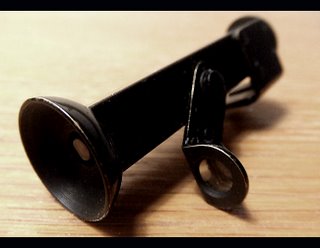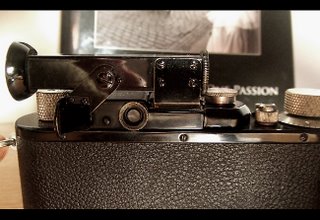Do you WINTU?
Trivia: Leica normally issues a five letter code for their accessories - VIDOM, FISON, SCNOO, etc. They are all 'pronounceable' and the intent was that it was easier to remember a code like this than something like FL-1560.
Anyway, a few weeks ago I added another five-letter accessory to my user-collection. The WINTU is a finder from the 30's-40's that allows you to view - and focus - whilst holding the camera at a 90 degree angle from you (having it aimed at your subject). It's quite ingenious in it's simplicity - there are two windows to look at: the viewfinder is placed so that it's directly above the camera viewfinder and provides exactly the same view (through a mirror) and there is a second, smaller, window that covers the rangedfinder window on the camera and once again through a mirror allows you to see the rangefinder through this 90 degree contraption.
Sounds bizarre and hard to imagine? Well, they say a picture is worth a thousand words - so here are a few thousand words describing what the WINTU looks like ontop of my Leica III (F).
 The WINTU, showing the two finders - the larger is the viewfinder and the smaller one provides the view of the rangefinder window.
The WINTU, showing the two finders - the larger is the viewfinder and the smaller one provides the view of the rangefinder window.

The WINTU mounted on my Leica III (F). As you can see the viewfinder is directly above the camera's viewinder.

Rear view of the finder. As can be seen here the smaller lever goes down and covers the rangefinder window allowing it to be projected through the 90 degree finder.
Now, how 'stealthy' a photographer will this make you..and how 'useful' is it really in real life? Well, Walker Evans supposedly used one of these but in these modern days with digital cameras sporting LCD finders that often turns and twists and allows for waist, angled, over the head, etc - shooting this gadget won't make anyone invisible. Rather the oposite taking into consideration that you're yielding a 60-70 year old piece of equipment around - but it's bound to be fun to use and isn't that what it's all about in the end?
In 1933 the WINTU, as seen in an original ad below, sold for $8.91 - taking inflation into consideration that translates to about $130 today. I paid about $30 for mine in 2006 - so in a way that can almost be seen as a bargain :)
(The WINTU is an 'updated' version of the WINKO (also mentioned in the ad below)).


5 Comments:
Rich -- Now I know what the Leica designation is! I need one of these. I just finished reading a great book about one of my favorite photographers, and artist, Ben Shahn: Ben Shahn's New York: The Photography of Modern Times. While a painter he took up street photography in the early 1930s with a Leica A and a right angle finder. I'm not sure how much Walker Evans used one but Ben and Walker shared a studio then and they were great friends. Ben was one of the early FSA photographers under Roy Stryker and help set the direction of the FSA. All his New York street photography was with a right angle finder. I've seen recent comments that it wouldn't fool anyone today. I disagree. I find using a TLR fools people. I didn't realize it had a little mirror for the rangefinder too! This is too cool. Ben's probably didn't have the rangefinder mirror since the Leica A didn't have a rangefinder. Fedka even has a russian copy. They want more than two WINTUs that are currently on eBay. Have you used it?
Gordon,
I haven't used any other 'wintu' than this Leica-made one.
It's a neat contraption but even though it 'does work' it is certainly not the most convenient way there is to take photos :)
I'm also not too sure it does 'fool' anyone since keep in mind the camera and lens is of course still facing the subject.
The second mirror for the rangefinder patch is very cool and does actually work - it's slow to use ofcourse but I'm really amazed about the design and the thought that went into this - and as you mention: the history about how this was used and by what photographers.
Does it make photography more convenient and stealthy?
Well, not really....
Is it fun though?
Heck, yes. :-)
Fun good!
Rich- I've enjoyed your entries for some time, but I want to add one point. The five letter code for products was also instituted by Leica to make it easy, fast, and cheap for dealers to report sales numbers and order items through the telegram system, which was the fastest long-distance communication at the time. Telegrams were charged by the number of letters in a message, so keeping the number down was helpful; five letters allowed a cute pronouncable name, but also left room for a unique code for each item then made.
Dru, thanks for that piece of information - I had no idea that this was also part of the origin of the codes. Happy to hear you have been enjoying the entries. I will try to do a better job of posting more regularly - my 'goal' is to make at least one entry/week going forward.
Post a Comment
<< Home